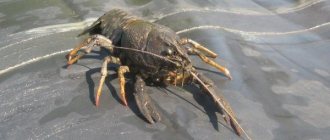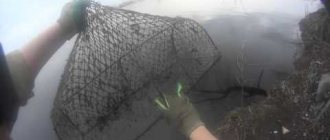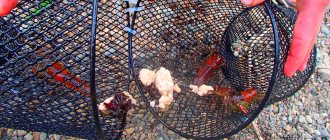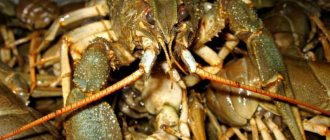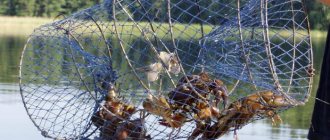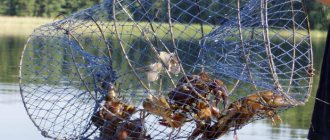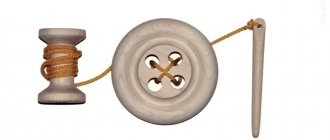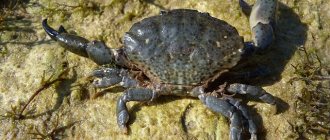- In which territories of the Krasnodar Territory is recreational fishing prohibited?
- Prohibited periods (periods) of extraction (catch) of aquatic biological resources
- Types of aquatic biological resources prohibited for extraction
- Prohibited fishing methods and gear in the Krasnodar Territory
- Minimum size of aquatic biological resources caught
- Daily fish catch rate
Fishing rules in the Krasnodar region in the Black Sea basin
- In which areas is recreational fishing prohibited?
- Prohibited periods (periods) of extraction (catch) of aquatic biological resources
- Types of aquatic biological resources prohibited for extraction
- Types of prohibited tools and methods of extraction (catch) of aquatic biological resources in the Black Sea basin
- Minimum size of aquatic biological resources caught
- Daily fish catch rate
In 2020-2021, the Federal Law on Recreational Fishing came into force, but its provisions also do not contain specific prohibitions and rules for fishing. This law contains general provisions regarding recreational fishing.
Specific fishing rules are approved for each fishing basin.
On the territory of the Krasnodar Territory in the territory of the Republic of Adygea, the Fishing Rules for the Azov-Black Sea fishery basin are in force, approved by Order of the Ministry of Agriculture of Russia dated 01/09/2020 N 1 (as amended in force in
2021
year).
The Azov-Black Sea fishery basin includes the Black and Azov seas with the basins of the rivers flowing into them and all water bodies of fishery importance of the Republic of Adygea, the Republic of Kalmykia (with the exception of the Caspian Sea with the basins of the rivers flowing into it), the Karachay-Cherkess Republic, the Republic of Crimea, Krasnodar and Stavropol Territories, Volgograd (Don River Basin), Voronezh, Lipetsk, Rostov, Saratov (Don River Basin) and Tula Regions (Don River Basin), the federal city of Sevastopol, with the exception of ponds, watered quarries owned by the constituent entities of the Russian Federation Federation, municipal and private property.
Important. On the territory of the Krasnodar Territory, various fishing rules have been established on the internal rivers of the region in the Sea of Azov and in the Black Sea.
Fishing rules in the Krasnodar region in the Azov Sea basin
Prohibited territories for fishing of biological resources in the Azov Sea basin
Fishing rules establish areas prohibited for the extraction (catch) of aquatic biological resources in the Krasnodar Territory, included in the Azov Sea basin:
- in spawning and fish passage (bypass) channels of waterworks;
- within the protected exclusion zones of hydraulic structures and bridges established in accordance with the legislation of the Russian Federation;
- on canals of spawning and rearing farms, with the exception of canals or parts thereof provided for the organization of amateur and sport fishing;
- in the Sea of Azov, the Kerch Strait and the Taganrog Bay - at a distance of more than 1.5 km from the coast;
- from November 15 to March 31 - in wintering pits specified in the “List of wintering pits located on water bodies of the Krasnodar Territory and the Republic of Adygea” (see table below).
List of wintering pits located on water bodies of the Krasnodar Territory and the Republic of Adygea
Name of the wintering pit
| Location | |
| Water bodies of fishery importance in the Krasnodar Territory and the Republic of Adygea | |
| Konokovskaya | Kuban River (Uspensky District): located 100 m downstream from the administrative border of the village of Konokovskaya. |
| Caucasian | Kuban River (Caucasian region): located 1300 m downstream from the Kadushkino tract on the right bank of the river |
| Red 4 | Kuban River (Ust-Labinsky district): located 1 km downstream from the administrative border of the Krasny village village |
| Ladozhskaya 3 | Kuban River (Ust-Labinsky district): located 1 km downstream from the Ladoga Bridge |
| Zelenchukskaya | Kuban River (Ust-Labinsk region): located 1.2 km downstream from the mouth of the Zelenchuk River |
| M. Bolgovskaya 2 | Kuban River (Ust-Labinsky district): located 2 km downstream from the administrative border of the village of Maly Bolgov |
| Nameless 4 | Kuban River (Ust-Labinsky district): located 1.5 km downstream from the administrative border of the village of Kubansky farm |
| Maykop | Kuban River (Ust-Labinsky district): located 200 m upstream from the Maykop bridge |
In water bodies of fishery significance in the Krasnodar Territory and the Republic of Adygea, the extraction (catch) of all types of aquatic biological resources is prohibited:
- in front of river mouths at a distance of less than 500 m on both sides of the mouths;
- in inter-estuary connections, as well as in the branches listed below: Peresypskoye (Akhtanizovskoye) - at a distance of less than 500 m from the western and eastern shores, deep into the sea - less than 300 m and deep into the Akhtanizovsky estuary - less than 300 m;
- Solovyovskoye - at a distance of less than 500 m on both sides of the arm and deep into the sea - less than 300 m;
- Kulikovskoe, Sladkovskoe, Gorkovskoe, Zozulievskoe and Avdeevo (Godzhievskoe arm canal) - at a distance of less than 500 m on both sides of each arm, less than 300 m deep into the sea;
- Novo-Chapayevskoye, Chapaevskoye, Krutoberezhnoe and Grekovo - at a distance of less than 300 m on both sides of each arm, deep into the sea - less than 200 m and less than 200 m deep into the Akhtarsky estuary;
- Kuchugurskoye (sea discharge of the Chernoerkovsky spawning and breeding farm) - at a distance of less than 500 m on both sides of the arm, deep into the sea - less than 300 m and along the channel bed - less than 300 m;
- Yasenskoye (Beysugsky estuary) - at a distance of less than 500 m on both sides of the arm, less than 300 m deep into the sea, and also less than 300 m deep into the Beysugsky estuary.
Prohibited periods (periods) for the extraction (catch) of aquatic biological resources:
- from September 15 to November 30 - trout in water bodies of fishery importance located within the administrative boundaries of the Karachay-Cherkess Republic;
- Kuban River: from the Red Bridge of the Dautsky Nature Reserve upstream to the source.
- from April 1 to May 31: at a distance of less than 500 m from road (related to federal highways) and railway bridges located on all non-navigable rivers of the Azov-Black Sea fishery basin;
- in all water bodies of the Republic of Adygea, with the exception of the extraction (catch) of aquatic biological resources with one float rod or bottom fishing rod with one hook per citizen, spinning from the shore without the use of all types of vessels or floating craft;
Prohibited periods for catching crayfish in Kuban:
- from January 1 to June 14 – fishing of freshwater crayfish in water bodies of the Krasnodar Territory (except for the Azov estuaries) and the Republic of Adygea is prohibited;
- throughout the year – fishing of freshwater crayfish in the Azov estuaries of the Krasnodar Territory is prohibited.
Species of aquatic biological resources prohibited for production (catch) in the Kuban in the waters of the Sea of Azov:
- marine mammals, sturgeon species of fish, Black Sea salmon, shemaya, light croaker, gurnard, carp, flounder, lampreys, oysters, Black Sea crabs, pearl mussels, Russian bystryanka, common sculpin, female freshwater crayfish bearing eggs and larvae;
- species of fish grown for the purposes of aquaculture (fish farming) - in fish breeding areas provided for use by fish farms.
In the case of production (catch) of prohibited species of aquatic biological resources, they must be released into the natural habitat with the least damage, regardless of their condition.
Prohibited fishing methods and gear in the Krasnodar region in the Azov Sea basin
For amateur and sport fishing, the use of:
- networks of all types;
- traps of all types and designs (merezh, venter, top, “muzzle”, “pins” and others), with the exception of crayfish traps, the use of which is allowed for catching crayfish in freshwater bodies;
- passive mining (catching) tools (“zakidushki”, “deliveries”, “pokes” and others) on rivers that are habitat for trout;
- fishing rods (including bottom fishing rods) and spinning gear of all systems and types with a total number of hooks (single, double or triple) of more than 10 pieces per citizen;
- trawling and dredging mining (catch) gear;
- straining and seizing fishing gear (catch) and devices (drags, seines, drags, bastings, lifts, “TVs”, “screens”, “spiders”, “grabs”, “drills”, “shards”, “capes”, “ kerchiefs", "saks", "kotsov", "krylatok", "Germans", "vozmilok" and others), with the exception of lifts ("spiders") and scoops - no more than one piece per citizen, size (length, width, height) no more than 100 cm, and mesh size (pitch) no more than 10 mm (including those used with bait) for the production (catch) of live bait (bait), except for especially valuable and valuable species of fish;
- traps,
- self-catching (red-head) hook tackle;
- piercing fishing tools (catch), with the exception of amateur and sport fishing, carried out using special pistols and guns for underwater hunting;
- firearms and pneumatic weapons, crossbows and bows;
- mining (catch) gear that affects aquatic biological resources with electric current, as well as explosive, toxic, narcotic drugs (substances) and other mining (catch) gear prohibited by the legislation of the Russian Federation;
It is also prohibited to extract (catch) aquatic biological resources:
- by the method of purpleing, jamming, rutting (including with the help of rattling and bogging);
- by saddles;
- “for illumination” - using lighting devices and lanterns of various designs from the surface and in the water column at night (astronomical, from sunset to sunrise) time of day for the extraction (catch) of aquatic biological resources, with the exception of fishing using fishing rods ( including bottom fishing rods) and spinning gear of all systems and names, as well as crayfish traps;
- on the track - using a rowing vessel or floating craft using more than two baits per vessel or floating craft;
- for trolling - using a sail and/or motor using more than two baits per vessel or floating craft;
- circles and girders with a total number of hooks (single, double or triple) of more than 10 pieces on the fishing gear of one citizen;
- by installing driveways, fences, pins, dams and other types of barriers that partially or completely block the bed of water bodies and prevent the free movement of fish;
- more than 5 crayfish traps per citizen, each of the parameters of the permitted crayfish traps (length, width, height - for polygonal ones, height, diameter - for conical and cylindrical ones) should not exceed 80 cm;
- Black Sea stone and grass shrimp, pontogammarus and chironomids with a lifting net more than 70 cm in diameter;
- mussels and rapana with nets more than 70 cm in diameter;
- using the gill method (using bagasse traps, “harvesters”) with more than one single hook;
- freshwater crayfish by wading or diving.
The minimum size of extracted (caught) aquatic biological resources (commercial size) in the Azov Sea basin.
When carrying out recreational and sport fishing, it is prohibited to harvest (catch) aquatic biological resources that have a fresh length less than that indicated in the table below (commercial size)
Minimum sizes of permitted fish catch
| Name of aquatic biological resources | Length, cm |
| Pike perch in the Chograi reservoir, lakes and reservoirs of the Stavropol Territory and the Karachay-Cherkess Republic | 35 |
| Pike perch in other water bodies of fishery importance | 38 |
| Freshwater catfish | 60 |
| Carp | 35 |
| Taran | 16 |
| Rybets, raw | 22 |
| Sinets | 24 |
| white cupid | 45 |
| Bream in the Azov estuaries of the Krasnodar Territory and in the Chogray reservoir | 17 |
| Bream in the Sea of Azov, Taganrog Bay, in the Don River, reservoirs of the Krasnodar Territory and the Republic of Adygea | 28 |
| Bream in other freshwater bodies of fishery importance | 24 |
| Bream in the Tsimlyansk Reservoir | 27 |
| Brown trout (freshwater resident form) | 15 |
| Barbels | 20 |
| Podust | 15 |
| Bersh | 26 |
| Asp | 35 |
| Silver carps | 50 |
| Chekhon | 24 |
| Black Sea-Azov herring, migratory and sea herring | 15 |
| Pilengas | 38 |
| Chub in lakes and reservoirs of the Stavropol Territory and the Karachay-Cherkess Republic | 22 |
| Chub in other water bodies of fishery importance | 28 |
| Tench | 17 |
| Pike | 30 |
| Ide | 26 |
| Gobies | 10 |
| Crayfish (freshwater crayfish) | 9 |
| Crayfish (freshwater crayfish) in the Tsimlyansk Reservoir | 10 |
| Flounder glossa | 17 |
| Mullet (singil, mullet, pointed nose) | 20 |
| Horse mackerel | 10 |
The commercial size of aquatic biological resources is determined in fresh form:
- in fish - by measuring the length from the top of the snout (with the mouth closed) to the base of the middle rays of the caudal fin;
- in crustaceans, by measuring the body from a line connecting the middle of the eyes to the end of the tail plates.
Extracted (caught) aquatic biological resources that are shorter than the permitted length are subject to immediate release into the natural habitat with the least possible damage.
Permitted daily fish catch rate in Kuban
The daily rate of production (catch) of aquatic biological resources in the Kuban in the Sea of Azov and the rivers included in its basin (except for the case where such aquatic biological resources are subject to a permanent or temporary ban on production (catch) during recreational fishing), for one citizen when carrying out recreational fishing is indicated in the table below.
Daily catch rate
| Name of aquatic biological resources | Daily rate of production (catch), kg/individual. |
| Zander | 2 copies |
| Freshwater catfish | 2 copies |
| Carp | 3 copies |
| Garfish | 5 kg |
| Taran | 5 kg |
| Rybets, raw | 5 copies |
| Sinets | 5 kg |
| white cupid | 2 copies |
| Bream | 5 kg |
| Brown trout (freshwater resident form) | 5 copies |
| Barbels | 5 kg |
| Podust | 5 kg |
| Bersh | 5 copies |
| Asp | 3 copies |
| Silver carps | 2 copies |
| Chekhon | 5 kg |
| Black Sea-Azov herring, migratory and sea herring | 5 kg |
| Azov belly | 5 kg |
| Pilengas | 5 kg |
| Chub | 5 kg |
| Tench | 5 kg |
| Pike | 5 kg |
| Ide | 5 kg |
| Gobies | 5 kg |
| Flounder-kalkan | 2 copies |
| Flounder glossa | 5 kg |
| Mullet (singil, mullet, pointed nose) | 5 kg |
| Horse mackerel | 5 kg |
| Mussels | 5 kg |
| Rapana | 10 kg |
| Crayfish (freshwater crayfish) | 30 copies |
| Shrimps | 2 kg |
| Artemia (including at the cyst stage) | 0.2 kg |
| Chironomidae | 0.5 kg |
| Polychaetes | 0.5 kg |
The total daily production (catch) rate for all types of aquatic biological resources (except rapana) indicated in the table is no more than 5 kg or one specimen if its weight exceeds 5 kg.
Catching crayfish
Crayfish are no less desirable prey than fish. Crayfish are very tasty and, to be honest, many people prefer crayfish with beer. In addition, crayfish can be used as fishing bait. A large crayfish reaches 20 cm in length (not counting the length of the claws), and its weight can be up to 200 g; however, catching such crayfish is a huge success for a crayfish fisherman. Most often, crayfish 10–12 cm long are caught using crayfish traps.
Where to catch crayfish
The answer to the question of where to catch crayfish is simple - crayfish are found exclusively in clean water bodies. If the water in a reservoir is heavily polluted or not rich enough in oxygen, then catching crayfish in it is a futile exercise. Therefore, it is better to catch crayfish in rivers than in lakes, where the water stagnates faster. Crayfish live at different depths: in some reservoirs you can catch crayfish by going into the water just above the knee, while in others you will have to catch crayfish at a depth of 2 - 3 m. Crayfish are lovers of rocky bottoms, in which they can find many hiding places. You can also catch crayfish in reservoirs with a clay bottom, in which crayfish dig holes for themselves under steep shady banks, the length of the holes is at least a meter. But where it is not worth catching crayfish is in shallow places with a hard sandy bottom; crayfish do not tolerate reservoirs with a muddy bottom densely covered with algae.
You need to know what time of day they catch crayfish so as not to waste it. As a rule, crayfish are caught at night - the time for effective catching of crayfish, when they go fishing, is from 22-00 to 3-00. There are reservoirs where crayfish go fishing in the early morning. As for the question of what time of year they catch crayfish, the answer cannot be unambiguous, since different regions have their own dates when it is possible to catch crayfish, and when there is a ban on catching crayfish. If you are wondering what month to catch crayfish, then it is believed that the most delicious crayfish are caught in early autumn. It is from the end of August to the end of October that crayfish meat becomes the fattest and most delicious. We hope that we have answered your question about which month is best to catch crayfish.
Ban on catching crayfish
Prohibitions on catching crayfish in the regions are established by the Fishing Rules for each fishing basin! Ban on catching crayfish in the Krasnodar Territory: For the Black Sea and the basins of rivers flowing into it, the ban on catching crayfish is valid from January 1 to May 31. For water bodies of fishery importance in the Azov Sea basin: from January 1 to June 14. The Kursk region prohibits catching crayfish from October 1 to June 30. During the period when crayfish can be caught, their size must exceed 10 cm. The Republic of Adygea has established a ban on catching freshwater crayfish in the water bodies of the Republic of Adygea from January 1 to June 14. The Rostov region has established a ban on catching crayfish: from January 1 to June 10 - freshwater crayfish in the water bodies of the Manych River basin; from January 1 to June 14 - freshwater crayfish in water bodies of the Rostov region (excluding the Manych River basin and the Tsimlyanskoye Reservoir); from January 1 to September 15 - freshwater crayfish in the Tsimlyansk reservoir; In water bodies of fishery significance in the Rostov region, the extraction (catching) of freshwater crayfish in the Koysug River (from the mouth to the confluence of the Chmutovaya River) is prohibited. During the period when it is possible to catch crayfish in the Rostov region, freshwater crayfish must be at least 9 cm, and freshwater crayfish caught in the Tsimlyansk Reservoir must exceed 10 cm. The Stavropol Territory has established a ban on catching freshwater crayfish in water bodies of the Stavropol Territory from December 1 until August 15th. The permissible size of crayfish for catching during the permitted period is 9 cm. Tambov region - the ban on catching crayfish is valid from October 1 to June 30. When you can catch crayfish, catch them at least 10 cm in size unless you want to get a fine for catching crayfish.
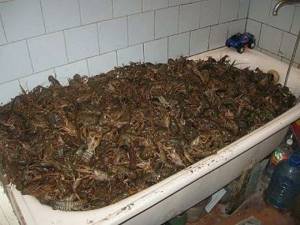
How to cook crayfish
Crayfish are caught and cooked in different regions from May to October, but the most delicious are those caught in early autumn.
It is from the end of August to the end of October that crayfish meat becomes the fattest and most delicious. Catching crayfish is only half the battle. The most important thing is to cook the crayfish correctly in order to fully preserve all the taste, aroma and tenderness. There are a huge variety of different recipes for cooking crayfish. Crayfish are boiled in water, milk or beer, fried in oil, soups, soufflés and many other dishes are prepared from crayfish. Preparing the Crayfish When you bring your crayfish home, immediately immerse them in a large container of fresh, clean water. This must be done to make it easier to wash their shells from adhering silt and dirt. After keeping your crayfish in water for one to two hours, rinse them thoroughly under running water. To improve the taste, washed crayfish can be placed in full-fat milk or water with sour cream diluted in it for half an hour. This will give your crayfish meat extra juiciness and tenderness. Rinse the crayfish soaked in this way with cold water and cook as usual. True crayfish lovers advise removing the stomach and intestines from the crayfish before cooking in order to rid the crayfish meat of even the slightest sign of bitterness. This is not difficult to do. Turn the crayfish onto its back, find the movable fins under the tail, grab them firmly with two fingers and with a rotational movement, gently pull them out along with the intestines. Recipe for cooking crayfish The most common and popular way of cooking crayfish is, of course, boiling. Let's start with the simplest thing and learn how to properly cook crayfish in salted water with herbs. Boil 2 liters of water in a deep saucepan, add 50 grams to boiling water. fresh dill or 2 tbsp. spoons of dill seeds, 1 tbsp. a spoonful of allspice and 2 tbsp. spoons of salt. Allow the spiced water to simmer for a couple more minutes and then submerge the washed and prepared live crayfish. Let the water return to a boil and cook the crayfish over high heat for 10 - 15 minutes, then remove the pan from the heat, cover and let your crayfish sit in the hot water for another 10 minutes. Serve immediately, placing the crayfish in a deep dish, pouring a small amount of broth and garnishing with fresh dill. Freshwater crayfish
The river crayfish cannot be confused with any of its other marine relatives. The most remarkable thing in the entire appearance of the crayfish is its tenacious claws, which replace the crayfish’s forelimbs. Claws are the main tool and weapon of cancer; without their help it cannot feed itself or fight off its enemies. The entire body of the crayfish is covered with a chitinous shell. The color of the chitinous cover of crayfish is not the same: in different reservoirs there are crayfish of their own color. It all depends on the colors prevailing in the bottom landscape: crayfish can be grayish-green, brownish, dark gray, or dark green, almost black.
Fishing rules in the Krasnodar region in the Black Sea basin
Areas prohibited for the extraction (catch) of aquatic biological resources in the Krasnodar Territory in the Black Sea with the basins of rivers flowing into it:
- in the rivers Psezuapse, Shah, Mzymta, Psou, their tributaries and at a distance of less than 1 km on both sides of their mouths;
- in front of river mouths at a distance of less than 500 m on both sides of the mouth;
- system of Kiziltash estuaries.
Prohibited periods (periods) for the extraction (catch) of aquatic biological resources:
- from April 1 to May 31 - in all water bodies of fishery importance, except for the Vityazevsky Estuary and the Black Sea;
- from January 1 to July 15 - crayfish (freshwater crayfish);
- from April 1 to August 31 - in the arms of estuaries and lakes connecting them with the Black Sea, and in front of the arms from the sea and estuaries at a distance of less than 500 m in each direction, as well as less than 500 m deep into the sea, lake or estuary;
- from November 1 to February 28 - all types of aquatic biological resources in the following areas:
- from August 20 to September 10 - mullet (singil, mullet, sharpnose);
- from May 1 to June 15 - gobies in the sea;
- from February 14 to May 1 - glossy flounder in the sea and in estuaries;
- from June 1 to August 31 - Black Sea stone and grass shrimp, mussels.
Species of aquatic biological resources prohibited for production (catch) in the Krasnodar Territory in the Black Sea basin:
marine mammals, sturgeon species of fish, Black Sea salmon, shemaya, light croaker, sea rooster, seahorse, green wrasse, rockfish, sea damselfish, monkfish, arnoglossa, bighead goby, barbel, trout, starfish, long-nosed and thick-nosed pipefish , carp, lampreys, baleen loach, small fish, four-lined goby, oysters, crabs, female freshwater crayfish carrying eggs and larvae.
In the case of production (catch) of prohibited species of aquatic biological resources, they must be released into the natural habitat with the least damage, regardless of their condition.
Types of prohibited tools and methods of extraction (catch) of aquatic biological resources in the Black Sea basin
For amateur and sport fishing in the Krasnodar Territory in the Black Sea and the river basins flowing into it, the use of:
- networks of all types;
- traps of all types and designs (merezh, venter, top, “muzzle”, “pins” and others), with the exception of crayfish traps, the use of which is allowed for catching crayfish in freshwater bodies;
- passive fishing gear (“zakidushki”, “postavushki”, “pokes” and others) in rivers where trout live;
- fishing rods (including bottom fishing rods) and spinning gear of all systems and types with a total number of hooks (single, double or triple) of more than 10 pieces per citizen;
- trawling and dredging mining (catch) gear;
- straining and seizing fishing gear (catch) and devices (drags, seines, drags, bastings, lifts, “TVs”, “screens”, “spiders”, “grabs”, “drills”, “shards”, “capes”, “ kerchiefs", "saks", "kotsov", "krylatok", "Germans", "vozmilok" and others), with the exception of lifts ("spiders") and scoops - no more than one piece per citizen, size (length, width, height) no more than 100 cm, and mesh size (pitch) no more than 10 mm (including those used with bait) for catching live bait (bait), except for especially valuable and valuable species of fish;
- traps;
- self-catching (red-head) hook tackle;
- piercing fishing tools (catch), with the exception of amateur and sport fishing, carried out using special pistols and guns for underwater hunting;
- firearms and pneumatic weapons, crossbows and bows;
- mining (catch) gear that affects aquatic biological resources with electric current, as well as explosive, toxic, narcotic drugs (substances) and other mining (catch) gear prohibited by the legislation of the Russian Federation;
It is prohibited to extract (catch) aquatic biological resources:
- by the method of purpleing, jamming, rutting (including with the help of rattling and bogging);
- by saddles;
- “for illumination” - using lighting devices and lanterns of various designs from the surface and in the water column in the dark (astronomical, from sunset to sunrise) for the extraction (catch) of aquatic biological resources, with the exception of fishing using fishing rods (including including bottom fishing rods) and spinning gear of all systems and names, as well as crayfish traps;
- on the track - using a rowing vessel or floating craft using more than two baits per vessel or floating craft;
- for trolling - using a sail and/or motor using more than two baits per vessel or floating craft;
- circles and girders with a total number of hooks (single, double or triple) of more than 10 pieces on the fishing gear of one citizen;
- by installing driveways, fences, pins, dams and other types of barriers that partially or completely block the bed of water bodies and prevent the free movement of fish;
- more than 5 crayfish traps per citizen, each of the parameters of permitted crayfish traps (length, width, height - for polygonal ones, height, diameter - for conical and cylindrical ones) should not exceed 80 cm);
- shrimp with a lifting net more than 70 cm in diameter;
- mussels and rapana with nets more than 70 cm in diameter;
- gill method (using bagasse traps, “harvesters”);
- freshwater crayfish by wading or diving.
Minimum size of extracted (caught) aquatic biological resources in the Black Sea (commercial size).
When carrying out recreational fishing, the extraction (catch) of aquatic biological resources that have a fresh length less than that indicated in the table (commercial size) is prohibited.
Minimum size of fish caught in the Black Sea
| Name of aquatic biological resources | Length, cm |
| Zander | 38 |
| Freshwater catfish | 60 |
| Carp | 30 |
| Taran | 16 |
| Rybets, raw | 22 |
| Sinets | 24 |
| Brown trout (freshwater resident form) | 15 |
| white cupid | 45 |
| Barabulya | 8,5 |
| Horse mackerel | 10 |
| Bream | 28 |
| Bersh | 25 |
| Asp | 35 |
| Silver carps | 50 |
| Chekhon | 24 |
| Black Sea-Azov herring, migratory and sea herring | 17 |
| Pilengas | 38 |
| Chub | 28 |
| Flounder-kalkan | 40 |
| Flounder glossa | 17 |
| Sea ruff (scorpionfish) | 15 |
| Pike | 30 |
| Ide | 26 |
| Gobies | 10 |
| Tench | 20 |
| Freshwater perch | 15 |
| Mullet (singil, mullet, pointed nose) | 20 |
| Mussels | 5 |
| Crayfish (freshwater crayfish) | 9 |
| Azov belly | 11 |
| Black Sea stone and grass shrimp | 3,5 |
| Mackerel | 15 |
The commercial size of aquatic biological resources is determined in fresh form:
- in fish - by measuring the length from the top of the snout (with the mouth closed) to the base of the middle rays of the caudal fin;
- in crustaceans - by measuring the body from the line connecting the middle of the eyes to the end of the tail plates;
- in mollusks (mussels and other bivalves) - by measuring the longest length of the shell.
Extracted (caught) aquatic biological resources having a length less than the permitted length are subject to immediate release into the natural habitat in a living form with the least damage.

